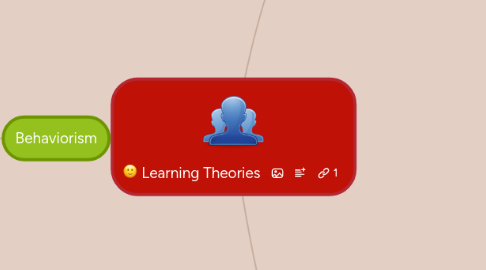
1. Behaviorism
1.1. Definition
1.1.1. a research method referring to the study human by observing their behavior
1.2. Representatives
1.2.1. Pavlov (1849-1990) – Watson and Skinner based the theory on studying Pavlov’s “digestive process of and the interaction of salivation and stomach”, a conditional stimulus and response experiment
1.2.2. John Broadus Watson (1878-1958) & B.F. Skinner (1904-1990)– “an experimental branch of natural science”, orientated towards the study, prediction and control of behavior.
1.3. Content
1.3.1. 1 Main Idea
1.3.1.1. Aims to promote and modify observable behavior
1.3.1.2. considers the human brain as a blackbox that can’t be accessed and that mind process are not important
1.3.1.3. is a process of stimulus-repose that one can observe and manipulate in which behavior can be changed as a result of providing motivators such as incentives, rewards and punishments
1.3.1.4. Most behaviorist instructional design model actually include cognitivist ideas on mental processes
1.3.1.5. Criticism
1.3.1.5.1. reinforcement/punishment patterns result varies, when rewards or punishment are ceased, making it difficult to measure learning outcomes when only certain tasks are performed – e.g. project-orientated learning related to real world situation
1.3.1.5.2. learning can be non-observable as human information processing may also be targeted by instructional strategies and methods but pure behaviorist design will ignore practices like reflection, motivation or cognitive load
1.3.2. 2 Teacher's Role
1.3.2.1. Positive/Negative Reinforcement – e.g. positive reward by giving student a praise
1.3.2.2. Positive/Negative Punishment - e.g. direct punishment by requiring students to stay after class
1.3.3. 3 Student's Role
1.3.3.1. Acquire knowledge by behaving appropriately to teacher’s requirement
1.4. Example
1.4.1. Gagne’s Nine events of instructions (partly cognitivist, partly behaviorist)
2. Cognitivism
2.1. Definition
2.1.1. Cognitive theory is a learning theory of psychology that attempts to explain human behavior by understanding the thought processes.
2.2. Content
2.2.1. 1 Main Idea
2.2.1.1. The assumption of congnitivism is that humans are logical beings that make the choices that make the most sense to them. Information processing is a commonly used description of the mental process, comparing the human mind to a computer.
2.2.2. 2 Teacher Role
2.2.2.1. information dispenser, transmitter
2.2.3. Student Role
2.2.3.1. information receiver, processor
2.3. Example
2.3.1. meaningful learning(Ausubel):students learn new knowledge to construct a substantive connection with the knowledge that already exist in their cognitive structure. For example, teachers will ask students to paraphrase the content of new-gained knowledge in different words to make sure they construct the meaningful connection.
2.4. Representatives
2.4.1. Newell and Simon and EPs;Ausubel
2.5. Technology
2.5.1. Organizing and brainstorming software such as MindMeister allows students to track their thinking and displaying their thoughts as a concept map. Then, they can easily see topics that may have commonalities, and link those concepts. The whole process contributes to information input to learners' cognition.
3. Constructivism
3.1. Definition
3.1.1. Constructivism is a theory of learning and an approach to education that lays emphasis on the ways that people create meaning of the world through a series of individual constructs.
3.2. Content
3.2.1. 1 Main Idea
3.2.1.1. Constructivism claims that knowledge is constructed through the interplay of existing knowledge and individual (or social) experience.
3.2.2. 2 Teacher's Role
3.2.2.1. Guide, facilitator of academic tasks
3.2.3. 3 Student's Role
3.2.3.1. Sense maker,self-directed learning
3.3. Example
3.3.1. Students learn concepts from teachers,then make a contact with their experiences and construct a new understanding of the concepts.Social constractivism and cognitive constractivism.
3.4. Representatives
3.4.1. Piaget, Von Glasersfeld
3.5. technology
3.5.1. Collins (1991) states, "So, inadvertently, technology seems to be coming down on the side of constructivists, who have been trying--unsuccessfully to date--to change the prevailing societal view of education" (p. 31). Why? Because computers undermine the didactic, lecture methodology, and, instead promote the student as a self-directed learner. " And so on. Useful website:http://delta.cs.vt.edu/edu/fis/techcons.html
